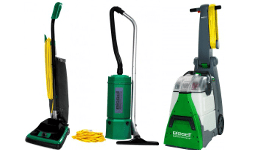Whats The Difference Between A Commercial Vacuum And A Residential Vacuum?
 The need to clean our homes has existed since the first people began roaming the earth. Thankfully, cleaning has also gotten much easier over the years as many tools now help us to keep our houses clean. The invention of the vacuum cleaner has revolutionized house cleaning.
The need to clean our homes has existed since the first people began roaming the earth. Thankfully, cleaning has also gotten much easier over the years as many tools now help us to keep our houses clean. The invention of the vacuum cleaner has revolutionized house cleaning.
The first powered vacuum cleaner was invented in 1901 by a British engineer named Hubert Cecil Booth and an American inventor named David T. Kenney. The vacuum was the first to ever use suction power and it was called the “Puffing Billy.” However, there is evidence that the first patent for an electric vacuum cleaner was granted to Corinne Defour who resided in Savannah, Georgia.
It was not until 7 years later, in 1908 that Hoover purchased John Murray Spangler’s patent for the upright vacuum. It then became known as the Hoover vacuum cleaner, many of which are still being made today; about 110 years later.
We can now do the housework by ourselves now, without the help of maids – and with the Roomba cleaning robot, we can now be at work or on vacation while this handy little vacuum does our work for us! Invented in 2002 by Helen Greiner, the Roomba is the perfect mechanical maid for anyone with pets or children.
Interestingly, there are even vacuums that can be installed inside your home where tubes run inside your walls and dump the debris into a large holding tank down in the basement or in your garage. This vacuum has ports throughout the house where a detachable hose can be plugged in so you can vacuum each room.
But wait, there is more! If you are tired of dragging a vacuum through the house or are not strong enough to push one around, Think Vacuums now sells both a residential and a commercial vacuum backpack so you can carry your vacuum around with you as you work.
Commercial Vacuum Cleaner vs a residential vacuum

Usually, a commercial vacuum works to service and clean a commercial-sized building. These come in both upright and canister style vacuums, and they tend to be bigger and sturdier than your typical household vacuums – they are designed to last for a while. They generally have longer cords (most of which have a 3 wire grounded chord), their dust bags are stronger and have a higher capacity, and their suction strength is more powerful. Although a Commercial Vacuum is more expensive, brands such as ProTeam, Bissell, and Sanitaire would be great to use for big, commercial cleaning projects.
A residential vacuum, however, is cheaper and is used often for a residential home or a small office space. These vacuums are smaller, are not as sturdy, and have less storage capacity. Some of the most popular brands include Kirby, Hoover, Sharp, Dirt Devil, and Eureka.
How a typical commercial Vacuum Cleaner works and what to watch out for
A vacuum cleaner uses air to create a vortex of suction inside the machine. Just like when we suck air through a straw, a vacuum sucks air and debris through its hose or its beater. Attachable powerheads and brushes on the end of a vacuum’s hose can help to catch dust and debris off of surfaces like window sills and kitchen cupboards, and it can make the surfaces shinier.
Whether you are using a commercial vacuum or a residential vacuum, they can still become clogged when the vacuums’ hoses or beaters get congested with debris or hair, rendering them almost useless. Make sure to check the hoses or beaters for clogs so that your vacuum operates with complete efficiency.
Vacuum filters can also become clogged if too much dust is “inhaled” by the machine. Check the filters frequently to avoid burning out your vacuum’s motor.
We provide Commercial Vacuum Cleaner Repair
What if your vacuum breaks? No problem! Here at Think Vacuums, we not only sell vacuum cleaners and their parts for both residential and commercial vacuums, but we also provide repairs for both kinds as well. We want our customers to be satisfied with our service so just call or come to visit us for any of your vacuum needs. See our reviews and ratings online.




Log In
Create New Account